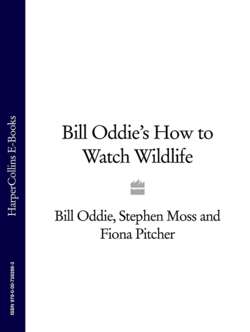Читать книгу Bill Oddie’s How to Watch Wildlife - Stephen Moss - Страница 7
ОглавлениеB
Wildlife beyond the garden gate
If you’re a city dweller, you may not think there’s much to see where you live. It’s easy to assume you have to travel to the coast or Britain’s deepest countryside for the true wildlife experience. But that is not always the case.
The fact is that modern farming methods, and loss of habitat through development and road building, have hit our countryside wildlife pretty hard. But being adaptable creatures, much of our wildlife has been moving into towns and cities, helped by the ‘wildlife corridors’ such as rivers, railway lines and strips of woodland, which enable them to travel from one place to another.
There are all sorts of advantages to living in towns and cities. For a start they are much warmer than the surrounding countryside, thanks to the waste heat from buildings. There is also far more food: either provided deliberately or by our wasteful habits. That’s why in recent years birds like ‘seagulls’ (or plain ‘gulls’, as they should really be called) have moved into our urban areas, where they feed by scavenging on rubbish tips and roost during the night on reservoirs. They have also started to nest on the roofs of city buildings, where they can be heard even above the noise of the traffic.
So if you’re a townie, rejoice in the fact that British wildlife is making itself seen and heard in cities everywhere. A good place to start is your local park: a green space where the wildlife can find food and shelter. Canals and rivers are also excellent places to look, as are odd sites such as churchyards and cemeteries – anywhere with a small patch of green and some areas of rough vegetation where the creatures can hide. Wildlife watching in cities isn’t always the most scenic of experiences, but it’s certainly full of surprises.
Bill's top tip
_ Get a friend to take you round their local patch and show you what’s there and what to look out for. Next time, try visiting the place on your own – you’ll be amazed at what you can find. This can be a real boost to your confidence.
Getting a local patch
Whether you live in the town or the countryside, a suburb or a village, you should be able to find yourself what naturalists call a ‘local patch’ – a place you can visit on a regular basis throughout the seasons to get to know the resident wildlife.
Urban parks are ideal as they offer a self-contained area that you can walk round in an hour or so. Other good local patches are gravel pits, reservoirs, woods and perhaps your nearest nature reserve – anywhere you can see a good variety of wildlife at different times. Another advantage is that most places like this are already being watched by a regular visitor, who may be able to give you some tips on what you are likely to see.
By visiting a local patch once or twice a week – or even a couple of times a month – throughout the year, you’ll soon become aware of the seasonal changes, such as when birds begin to sing, or the comings and goings of migrants. Over time you’ll be amazed at how much you have actually picked up over a few months of visiting.
One way to find a local patch is to check your local Ordnance Survey map using either the 1:50,000 scale Landranger series or, better still, the larger-scale 1:25,000 Pathfinder. Look for patches of water and woodland, which are good base camps for wildlife. Or contact your regional wildlife trust or ask at your library for information on local societies or bird clubs. The library may even have an annual report on your area’s wildlife.
But before you visit, check out details of access: although many places are open to the public or have footpaths running through them, at some, a permit or permission from the owner is required to gain entry.
Visiting nature reserves
If you’re lucky enough to have a nature reserve in your area, here’s a bit of advice. Your first visit to a reserve can fall short of expectations. Perhaps with the memory of zoos and nature programmes from childhood, the very notion of a reserve suggests a place teeming with wildlife from dawn to dusk. Few actually deliver this. In fact, you can sometimes walk for a good 20 minutes from a reserve entrance or car park before you see anything at all. And if you go into a hide expecting to see the birds performing in front of you, well, prepare to be disappointed. However, good things do come to those who wait – and look, and listen – and come back again, and again.
